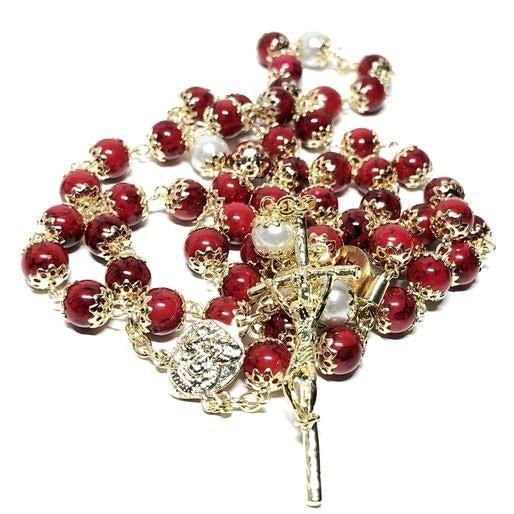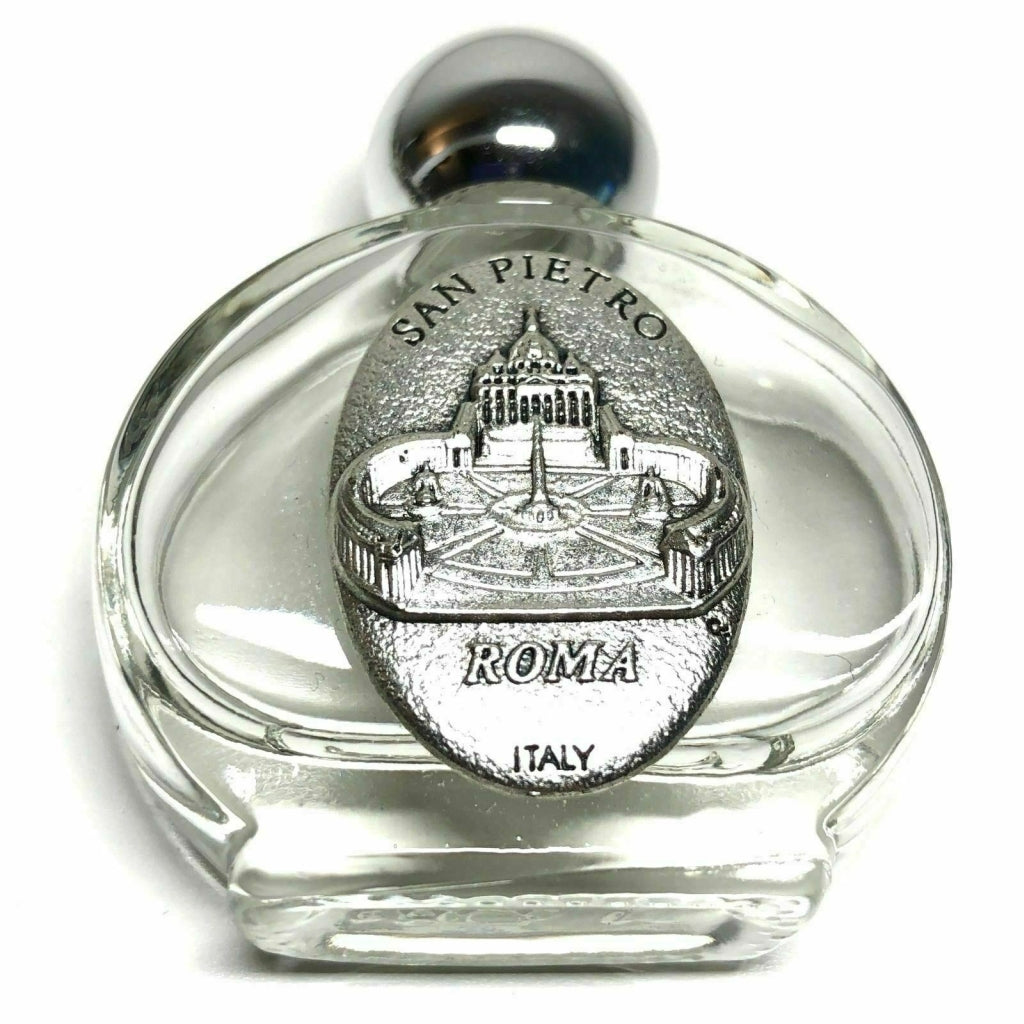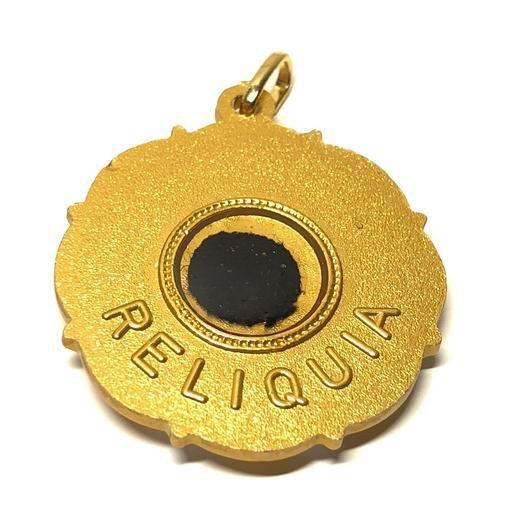Praying the rosary is easy with a little practice and understanding. Prayer is the lifting and opening of one's self to God. Though it takes many particular forms, there are three basic, formal methods of prayer:
- Vocal prayer in which one says aloud the words he wishes to express to God, whether these words be spoken, sung, chanted or even 'said' silently in the heart. Most group, liturgical and even private prayer is of this kind.
- Meditative in which one actively, mentally engages an event or concept in the mind, often while the body engages in apparent vocal prayer of some sort.
- Contemplative in which one silently (usually) enters into and experiences God's intimate presence.
A specific, arranged set of prayers is properly referred to as a chaplet. There are hundreds of different kinds of chaplets, but the chaplet known as the rosary is by far the most popular. Were it merely a vocal form of prayer, the rosary would not be of much worth, for it seems there could be little purpose in simply repeating the same prayer over and over tens or hundreds of times a day (though one could counter by saying that spouses never tire of hearing 'I love you'). But the rosary is a meditative form of prayer in which the body engages in physical activity and repetitive prayer while the mind focuses upon key events in Christ's ministry. Because we are not only spirit but also flesh the Church has long recognized that it assists us in prayer and worship to occupy the body as well as the mind. Posture, sight, sound, touch and smell affect our worship. Jesus often used simple matter as the medium through which He worked miracles; touch, water, fish, bread, wine, mud and even spit. And so, in the case of a rosary, the pattern on the beads occupy the hand as the image of our Savior's saving act occupies the eye on the crucifix.
The use of beads as aids in prayer goes back centuries. Indeed, the word 'bead' means 'prayer.' The word 'rosary' is commonly used to refer to the set of beads, but more properly refers to the actual set of prayers, whether or not it is actually aided by beads. For example, 'the rosary' is prayed by many in full or in part without any beads whatsoever; the beads are simply an aid. The rosary has been prayed by Christians throughout the world for at least five hundred years. The purpose of the prayer is to join one's heart and life more intimately with our Savior, Jesus Christ, through contemplation of key events in salvation-history. Catholics believe that by meditating upon the teachings and actions of Christ, by opening our minds and hearts to such frequent meditation, that God can change us to become more like what He intends us to be. Theologically, it is proper to refer to the rosary as a sacramental or popular piety, meaning that it is often a blessed object and a popular religious activity. Indeed, among all non-liturgical prayers it is without a doubt the one most encouraged by the Church. However, it is not a 'Sacrament,' and though it is an honored tradition in the Catholic church and highly recommended, knowledge and prayer of the rosary is not necessary for salvation or personal holiness, though for many, many people it is instrumental in bringing these about.
It has strong historical connections to what is today called the Liturgy of the Hours, in which one prays the Psalms and meditates upon other Scriptural readings. For example, until recently the rosary had 15 sets ("decades") of ten prayers each, or 150 prayers, each representing one of the 150 psalms which make up the core of the Liturgy of the Hours.
The most common type of rosary is the Dominican rosary, named for St. Dominic who, according to tradition, received it from Mary, the mother of Jesus. The full Dominican rosary consists of 166 beads connected by chain, cord or similar material. Some don't have beads at all, but just knotted cord. 153 of the beads are called "Hail Mary" or "Ave Maria" beads because the Hail Mary prayer is prayed on each of them. The other 16 beads are "Our Father" or "Pater Noster" beads because the Our Father prayer is prayed on each of them. The Hail Mary beads are organized in sets of ten beads, each set of ten called a decade. Each decade is preceded by one Our Father bead. On each decade one mystery of Christ's life is the center of meditation. These mysteries are the focal point of the rosary prayer. Because most people do not have the time to pray a full rosary routinely (nor a large enough pocket to hold it), it is usually broken down into a smaller set consisting of only five rather than fifteen decades.
There are fifteen mysteries in all which are divided into three sets of mysteries: the joyful mysteries, the sorrowful mysteries and the glorious mysteries. In 2002, Pope John Paul II recommended the addition of another set of five mysteries, the "Mysteries of Light."
Following is an outline on how to pray the rosary.
Find a quiet place where you will not be interrupted while praying.
Begin by reciting the Apostles' Creed (some prefer to say the Nicene Creed) while meditating upon the crucifix.
I believe in God the Father Almighty, Creator of heaven and earth
and in Jesus Christ, His only Son, our Lord
Who was conceived by the Holy Spirit, born of the Virgin Mary
suffered under Pontius Pilate, was crucified, died and was buried.
He decended into hell; on the third day He arose again from the dead;
He ascended into heaven, and is seated at the right hand of God the Father Almighty;
from there He will come to judge the living and the dead.
I believe in the Holy Spirit, the Holy Catholic Church, the communion of saints, the forgiveness of sins, the resurrection of the body, and life everlasting. Amen
Then an introductory Our Father ("The Lord's Prayer") while holding the first bead above the crucifix...
Our Father who art in heaven
Hallowed be Thy name.
Thy kingdom come, Thy will be done
on earth as it is in heaven.
Give us this day our daily bread
And forgive us our trespasses as we forgive those who trespass against us.
And lead us not into temptation,
But deliver us from evil. Amen.
Now three Hail Mary's (considering the virtues of love, hope and faith) on each of the next three beads....
Hail Mary full of grace
The Lord is with thee.
Blessed art thou among women
And blessed is the fruit of thy womb, Jesus.
Holy Mary, Mother of God
Pray for us sinners now and at the hour of our death. Amen.
Then pray a 'Glory Be....'
Glory be to the Father and to the Son and to the Holy Ghost.
As it was in the beginning is now and ever shall be, world without end. Amen.
Some groups pray the more modern Glory be...
Glory to the Father and to the Son and to the Holy Spirit.
As it was in the beginning is now and will be forever. Amen.
Many groups add the Fatima prayer after the Glory Be...
O my Jesus, forgive us our sins, save us from the fires of hell, and lead all souls to Heaven, especially those in most need of Your Mercy.
Now begins the first meditation. Sometimes these are referred to as the "mysteries of the rosary" or the "rosary mysteries". Different meditations are traditionally prayed on different days. Select the appropriate meditation, below, and fix the story or image in your mind. When starting it is helpful to review the stories in the Bible or in a Scriptural Rosary book.
The joyful mysteries of the rosary -- prayed on Mondays and Saturdays (and Sundays during the Advent/Christmas season) -- can all be located in the first two chapters of the Gospel of Luke in the Bible. The joyful mysteries are:
- The angel's annunciation of Christ's coming
- Mary's visit to Elizabeth
- The birth of Christ
- Jesus' presentation in the temple as an infant, and
- Finding the boy Jesus in the temple.
The mysteries of light (also known as the luminous mysteries of the rosary), recommended in 2002 by Pope John Paul II and prayed on Thursdays, add five more meditations to the rosary related to Christ's life and teachings:
- Christ's baptism in the Jordan
- Christ's self-manifestation at the wedding at Cana
- Proclamation of the Kingdom of God and call to conversion
- Transfiguration, and
- The Last Supper and institution of the Eucharist.
The sorrowful mysteries of the rosary, prayed on Tuesdays and Fridays (and Sundays of Lent), can be found in the last chapters of the Gospels of Matthew, Mark and Luke. The mysteries are:
- Christ's agony in the garden
- His scourging
- His being crowned with thorns
- Christ carrying the cross, and
- His crucifixion and death.
The glorious mysteries of the rosary, prayed on Wednesdays and Sundays (except as noted, above), can be found in the last chapter of the Gospel of Luke, the second chapter of the Book of Acts, and Revelation 12. They are:
- Christ's resurrection
- His ascension into heaven
- The sending of the Holy Spirit
- Mary's assumption into heaven, and
- Mary's coronation in heaven.
While contemplating the meditation pray one Our Father, ten Hail Mary prayers, then a Glory Be (and, optionally, the Fatima prayer). Repeat the pattern -- Our Father, ten Hail Mary's, Glory Be, Fatima Prayer -- with each mystery.
When finished meditating upon the mysteries, most people conclude the rosary with the Hail Holy Queen prayer:
Hail, holy Queen, Mother of Mercy! our life, our sweetness, and our hope! To thee do we cry, poor banished children of Eve; to thee do we send up our sighs, mourning and weeping in this valley, of tears. Turn, then, most gracious Advocate, thine eyes of mercy toward us; and after this our exile show unto us the blessed fruit of thy womb, Jesus; O clement, O loving, O sweet Virgin Mary.
SIMPLE TABLE OF ROSARY MYSTERIES AND DAYS
This table incorporates the changes recommended by Pope John Paul II.
| Season | Sunday | Monday | Tuesday | Wednesday | Thursday | Friday | Saturday |
|---|---|---|---|---|---|---|---|
| Advent till Lent | Joyful | Joyful | Sorrowful | Glorious | Luminous | Sorrowful | Joyful |
| Lent till Easter | Sorrowful | Joyful | Sorrowful | Glorious | Luminous | Sorrowful | Joyful |
| Easter till Advent | Glorious | Joyful | Sorrowful | Glorious | Luminous | Sorrowful | Joyful |










